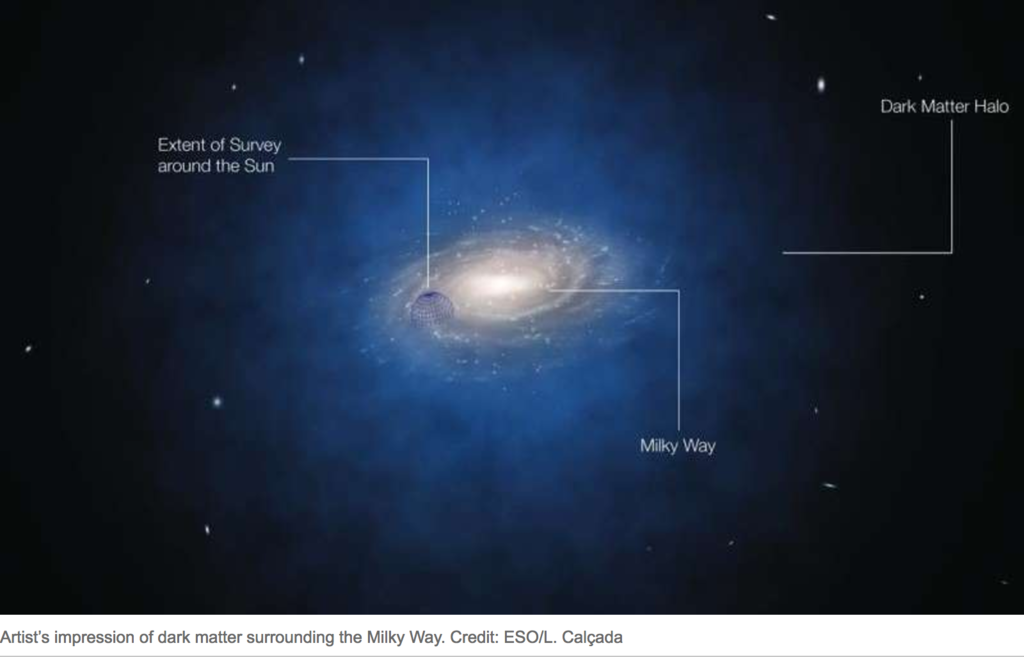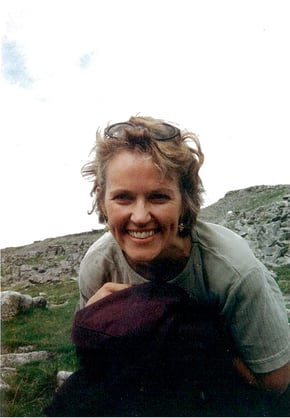In October, 2020, Nature magazine published an article on the “all out hunt for dark matter” with a last call for WIMPs (Weakly Interactive Massive Particles) as the likely new elementary particle.
Dark matter is thought to make up more than 95% of the matter in the universe. It is called “dark” because it does not emit light. Evidence for its existence appeared first in 1933 with the observation of astronomer, Fritz Zwicky, who found that the amount of light emitted from a nearby cluster of galaxies was significantly less than the calculated mass of that cluster (based on its gravitational behavior).
 Gtsourdinis, CC BY-SA 4.0, via Wikimedia Commons
Gtsourdinis, CC BY-SA 4.0, via Wikimedia Commons
In the 1980s, the observations of stars within galaxies made by Dr. Vera Rubin confirmed its existence, as have multiple observations and experiments since. As explained in “Dr. Vera Rubin and Why Dark Matter Matters,” there are many proposed theories to account for these unexpected observations.
After more than 40 years, however, the question remains: what is it?
According to the Lux Dark Matter Collaboration website, the most satisfying explanations propose a yet unidentified “elementary particle” (WIMPs being high on the list as noted in the Nature article above).
Italian physicist, Dr. Paolo Beltrame spent 15 years “on the hunt” for this non-radiating particle, and this hunt led him to God.
From Dark Matter to the Light of Faith
Dr. Beltrame summarized his journey this way:
"I got fascinated by physics, distorted by rational thinking and inebriated by vanity—to the point when I was telling God, ‘You are not there. And even if in the remote possibility You are there, I don’t really care: I put a super-impenetrable stone in front of Your grave.’” —Dr. Paolo Beltrame
Then, while teaching at the University of Edinburgh—skeptical but curious—he attended a lecture on Laudato Si hosted by the local Jesuit centre. That night his mind was opened to the possibility that one could have a rational, intelligent faith."
After this revelation, he simply continued with the business of hunting for dark matter. Christmas of 2015 found Dr. Beltrame in South Dakota, home of the Large Underground Xenon (LUX) dark matter experiment.
There, one night, his heart was opened to God. In his words, while his colleagues were with their families at Christmas:"I was in the middle of nowhere, alone . . . in a sea of white snow broken only by the grey of the laboratory building and spotted with green pines, when I encountered a herd of hungry deer.
'As the deer pants for streams of water, so my soul pants for you, my God.' (Psalm 42)
I was not really seeking God, at least until that moment. The deer suddenly and insistently suggested to me the presence of the loving and living God in all Creation, surrounding and embracing me." —Dr. Paolo Beltrame
This encounter had a profound effect on Dr. Beltrame. After an Ignatian retreat, and encouragement by Br. Guy Consolmogno S.J., head of the Vatican Observatory, he applied to and was accepted by the Jesuit order in Britain in 2017.
To hear Dr. Beltrame explain his story of conversion, see the video below:
On Faith and Science
Dr. Paolo Beltrame graciously answered questions for the Magis Center about his career, the rediscovery of his faith, and his new vocation as a Jesuit.
- MC: Your degree is in elementary particle physics. How did you become interested in this area?
PB: For as long as I can remember, I have had a deep feeling of wonder and awe for the cosmos and nature. A feeling accompanied by a deep and “stubborn” curiosity for the search for explanations of even invisible phenomena. Even as a child it was like this. I owe thanks to my mother (an extremely creative and imaginative person)—I think it was she who sowed a passion for non-technical curiosity in me. I have never been strongly interested in the technical applications of science, but rather in the intellectual satisfaction (consolation?) that comes from discovering the cosmos for what it is . . . Joking: science is like art, it is useless.
- MC: Which project do you consider the most significant in your scientific career? Among all the projects you have worked on, what new information or interpretation has startled you the most?
PB: The discovery of the Higgs boson was a long-awaited result that involved a huge organizational, practical and technological effort. Personally, I experienced it as being part of a great liturgical movement, but without transcendence. It is not by chance that particle accelerators are described as the cathedrals of the 21st century. I was tasked, along with others, with calculating and measuring the luminosity of the Large Hadron Collider, so that we can accurately identify the process that represents the fingerprint of the Higgs.
I would say that the search for dark matter was the project I was most passionate about. Of course, the discovery of the Higgs boson was also a very exciting project, but it may have been too broad in scope and, in the end, its discovery was almost inevitable. Dark matter is "something" much more enigmatic. If by "startled" you mean frightened, I can tell you that technology can be frightening, especially if they go hand in hand with financial inequalities—but not science. Science cannot be frightening. Knowing more makes you freer and less fearful. Even the Latins said, "Sapere aude," a motto taken up by Kant and the Enlightenment. Maybe I have a romantic view of scientific knowledge, but I don't think you can be afraid of science. I have been afraid of not having sufficient funds . . . or of not having time to meet deadlines, that is.
- MC: Are people surprised that you became a Jesuit? Are you surprised by this part of your journey? Would you mind sharing some of those details?
PB: My students at Edinburgh University thought I was going to be a Jedi. They didn't know what a Jesuit was. Maybe, just maybe, they do now. My choice surprised them, yes, I must admit. Two aspects in particular they did not understand: the fact that I might lose my freedom (because of the vow of obedience) and living in chastity. Regarding the first point, I rather think that a discernment made properly, together with the Superiors in the Spirit, does not limit freedom at all. On the contrary, it enriches it. It does not make it easier, but it makes it deeper and more deeply rooted. As for the second point, it seems to me that the Jedi also take a vow of chastity (but I could be wrong).
Does this surprise me personally? Of course it surprises me, I still don't understand it, and I don't think I will ever be able to. It surprises me and gives me consolation and difficulties/challenges at the same time . . . . But I think that consecrated life, as a Jesuit, is for me.
- MC: How would you describe the relationship between faith and science? In “A Lucky Universe?” you mention a “reasonable theism.” Can you elaborate on what you said there?
PB: The relationship between science and faith is a dance, in which both partners lead (I am not a dancer, I would like to make that clear . . . ). Science and faith remain distinct subjects, but not separate, and they both dance together and follow the same music—God and/or Nature, if you like. We must be careful not to step on each other's toes (which we have sometimes done, unfortunately) but to move them in harmonic synchrony. If you make a mistake, however, you learn. If suffering only provokes anger and revenge, it means that suffering has also been wasted.
- MC: Has your Jesuit theological training added to or changed this view?
PB: The thing that initially amazed me about theology was to find concepts expressed in an intelligent verbal manner that I already cultivated in myself, but in a more or less chaotic way.
It was a very pleasant surprise to find these confused ideas I had in my head (and/or heart) in thinkers like Rahner, Moltmann, Schillebeeckx, De Lubac, but also in St. Augustine or St. Irenaeus. More profoundly, I was also very stimulated and consoled to perceive how theology does not speak only to a part of man—as could be the case in physics, which is essentially addressed to rationality (except for a great emotional explosion, the Eureka moment)—but to man in his existential completeness. For this reason, it is impossible to have a univocal position in theology, but it is necessary to protect a rich plurality of sensibilities and languages within a living tradition, which courageously progresses.
- MC: Do you think a Theory of Everything is attainable?
PB: It is difficult to say whether the Theory of Everything (ToE) can be realized by humans and even more difficult to say when. One point that needs to be clarified first is: what is meant by the ToE? For professional physicists, it represents a unified description of the fundamental forces of nature. In this description, gravity will be unified with the forces of electromagnetic interaction and the nuclear forces (weak and strong). That is all. It sounds easy but it is not. But it might be feasible . . . once the difficulties of obtaining an experimentally reliable way of testing the theory have been overcome. If, on the other hand, by ToE one imagines a physical theory that describes everything, everything, everything—from the birth of the Universe to the Brexit, from particle physics to why we find a painting or a symphony beautiful—then this seems to me more like the subject of a science fiction film—not even a good one.
- MC: What do you think is the most important thing for people to understand about the universe or about science itself?
PB: Heisenberg wrote that, “Nature comes before man, but man comes before the science of nature.” I believe that people should see science as a path—even an uncertain one—towards the unknown. A non-dogmatic but (miraculously) well-ordered path that begins with awe and wonder, and is nourished by curiosity seeking not the “Truth” but the most plausible explanation of natural phenomena (phenomena, not things in themselves).
This should give science its due credibility and strip it of the messianic and mythical image that positivism had given it and which few scientists believe in any more. Science informs life, but does not cage it or force it in one direction or another.
In another reflection, Dr. Beltrame points to the significance of a personal encounter with God, such as he had on that beautiful crisp night in South Dakota.
"Starting from this encounter, the whole human person flourishes, including his/her intellectual and scientific activities, which can then be experienced with new colours: they become an enriching and challenging dialogue with God . . .
Perhaps we could see God as the author of a detective story: He will be much happier if we keep reading, understanding and savouring the novel, entering the mystery of it until the last page." —Dr. Paolo Beltrame
Cover Image: Artist's impression of the expected dark matter distribution around the Milky Way / ESA/Hubble, CC BY 4.0, via Wikimedia Commons
See Also:
Dr. Vera Rubin and Why Dark Matter Matters
Black Holes, Stephen Hawking, and the Evangelical Physicist Who Proved Him Wrong

